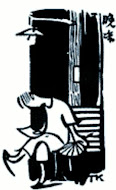Denise sent me a beatiful flower, Christmas Rose.
She said:
I thought about flowers in context of Christmas. The most popular plants are Holly, Ivy, Mistletoe and 'Christmas tree'.
But there is something else, a very nice flower: Christmas rose (Helleborus niger, Ranunculaceae). My mother brought it to my mind when she asked me for a painting of it. It is flowering in winter, from december to march, looking like a little star.
An old tale says a young shepherd was going to visit the newly born Jesus in the stable. He was very sad because he didn't have a present or even flowers for Jesus, and he started to cry. His tears fell down on earth and suddenly beautiful flowers sprouted out of it: Christmas-Roses.
Another (newer) tale is about an owl bringing a stalk with an ice crystal to Jesus. In the moment the owl put the ice crystal into the crib it turned into a flower - a christmas rose.
Helleborus niger has a long tradition as herb; all parts of it are poisonous. It is used (usually in homeopathy) as treatment of deseases of heart and blood circulation.

Denise's Christmas Rose
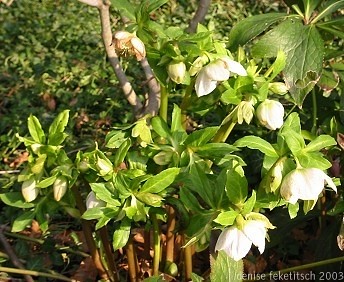
Shepherd's tears on earth
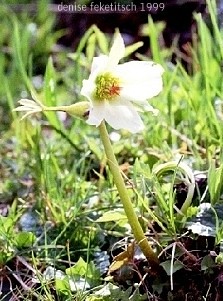
A stalk with ice crystal from owl
|
The Christmas rose is related to anemones, like the one you know from my homepage: Anemone sylvestris.
It also got a very nice English name: 'Snowdrop anemone'
[anemone 银莲花]
|
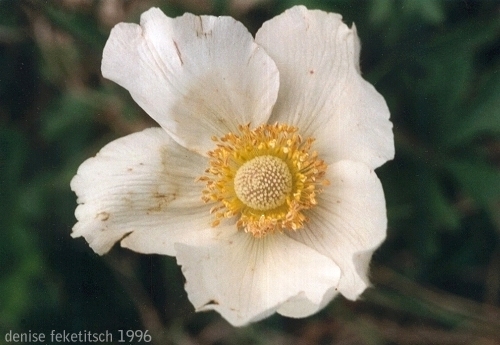
Denise's Anemone sylvestris
|
The flower seems familiar to me, although I know I never see it before.
What is it? I go back to the sunny summer afternoon at Rot. Flowers are blossoming, wasps are buzzing.
That afternoon the shuttle bus didn't come. We rushed out from Ralf's workshop: quick quick, we'll be late. Then waited at building gate. Time passed, we checked watch, well, we were on time. Then we began to suspect, did we understand the bus driver right in the morning? He said we should wait here, right?
Every day we praticed 3 words in German. Ah, that's good, helps everywhere. In the morning, say 'Morgan', then get on bus, say 'Danke'. Then arrive, say 'Danke' again, get off, say 'Tschuess!'. :) Of course in the afternoon, it is: Hallo! Danke! Danke! Tschuess!
The driver changes everyday, they are all very kind. Every morning when we arrived office building, they would tell us where to pick us up in the afternoon, in German and gesture.
So we three discussed and each got a task. George went back to office and called hotel about the shuttle. Kat waited there and began her gigarette break. I, went over the lane with flowers to the meeting point, see whether he was waiting us there.
So bright shining sun, I was happy with my camera to check over there.
The bus was not there, I shook back to Kat. And Kat shook back that bus didn't come yet. That's good, I took my time back. A very long walk.
Kat said, ah, you really walked very slow! Yes, stopped here and there. Every flower was blossoming.
George was still in office to make himself understood by the hotel girls. Kat had finished the cigarette. We had nothing to do. So, we both took out camera and focused on the buzzing wasps. :)
I got a lot of nice pictures.
A little later, hotel said the bus was coming. It turned out to be a handsome young lad with a very cool car! We all got in very happily.
|
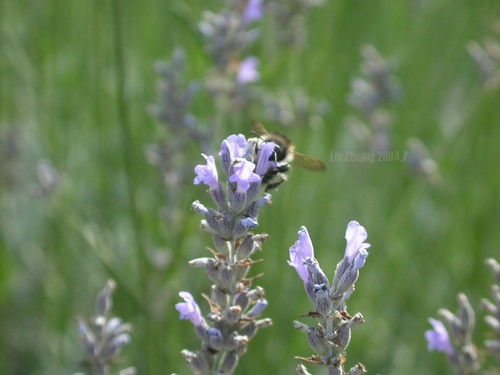
A wasp busy in lavendar

Lavendar blossoming
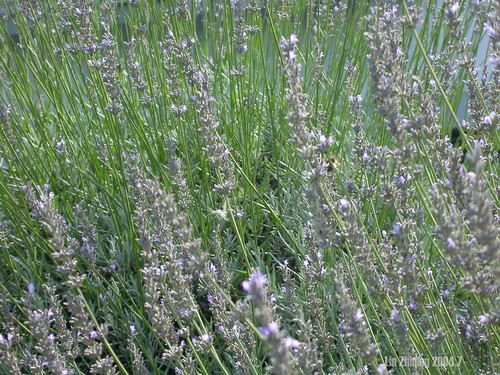
Lavendar bush, a lot of wasps buzzing in it
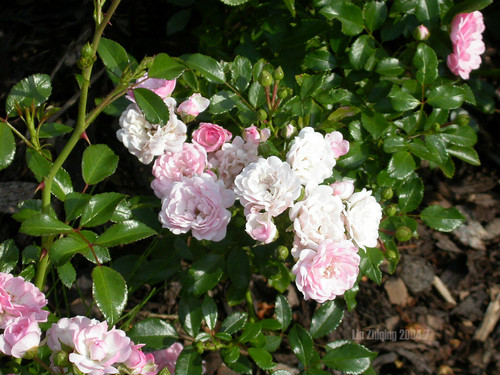
Roses
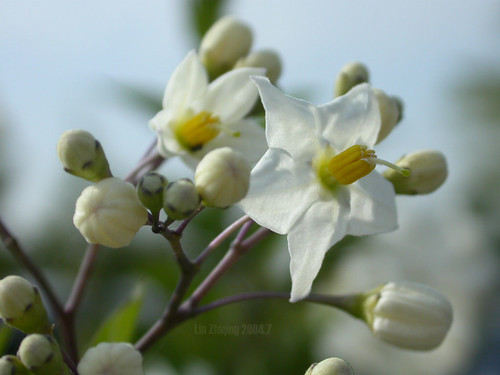
This flower is very beautifull, shivering in the wind. It's hard to focus on it. But once succeed, it is so nice.
Denise said:
This is from the family of nightshades (Solanaceae), very similar to potato, tomato etc. I guess it is black nightshade (Solanum nigrum) which is quite common around here. I like this plant because of its beautiful flowers and its nice name. It is very poisonous and used as a drug / herb.

I don't know what it is.
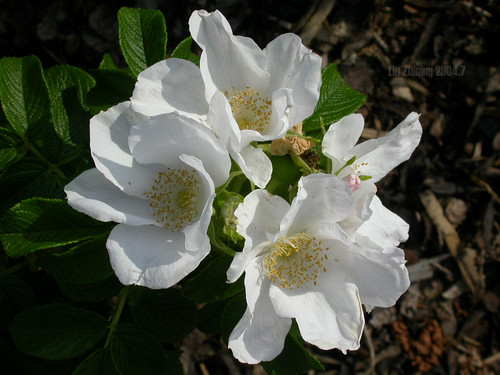
This is the one I feels like the Christmas Rose, only the flower.
Denise said:
Rosa rugosa, common names: rugose rose, potato rose, tomato rose, Chinese rose, Japanese rose... It comes from NO Asia. It is planted widely in Europe, at streets, on coast. I first met them in denmark, where lots of them grow in the sand dunes. Later they became common in our region, too. The fruits (rose hips) taste nice, but you have to be carefull not to eat the small hairs inside between the seeds, they cause itch.
The fruits - like other rose hips - are used as herbal tea.
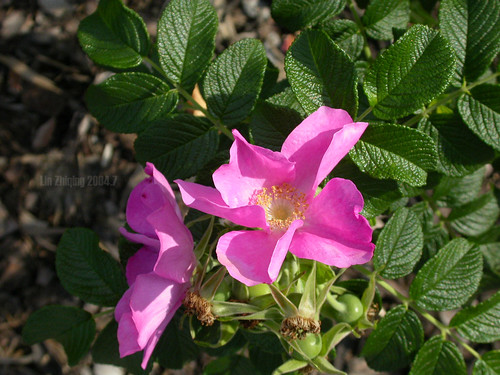
A pink version
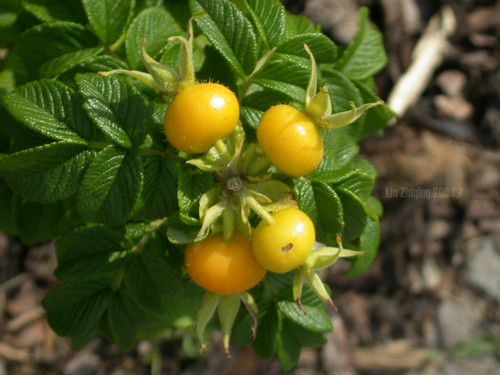
The small fruits with hairs.
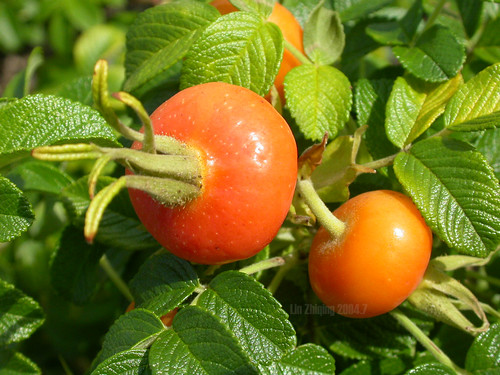
Bigger fruits.
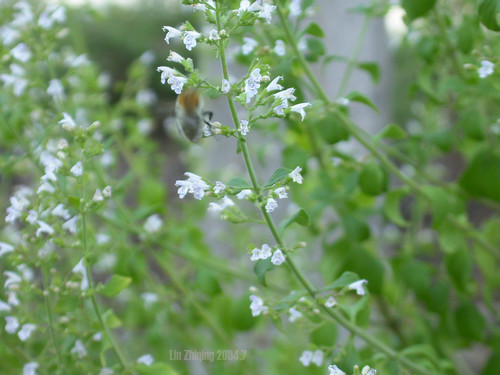
Another busy wasp
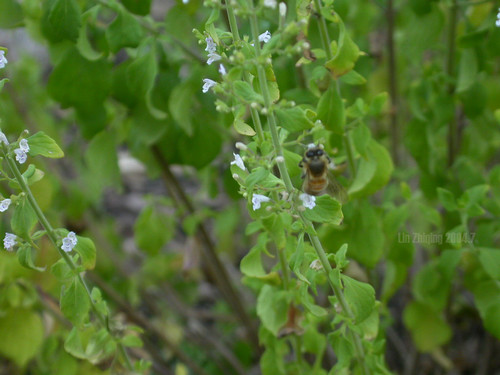
calmer wasp

A Friday afternoon at Rot. Duty off, weekend ahead.
|
Photos stored at:Christmas Rose and Flowers in Rot
-----------------------
Ah, recalling beebuzzing summerdays... your photos make this grey, cold and wet winterday brighter.
The pink flower between nightshade and rugose rose is a spirea, probably Spirea japonica. In English it is called 'meadowsweet' because of its sweet fragrance.
It belongs to the family of roses (Rosaceae).
Denise
评论人:dropin 评论日期:2004-12-19 22:15
Funny, the rugose rose comes from No asia, but it has the name of Chinese rose, Japnese rose. How it comes?
The rugose rose seems quite like the local wild rose here, 野蔷薇。which is scented ardently in late spring of May while warm bathing in bright sunshine.
The shepherd tear reminds me of peony, 牡丹,芍药, it seems to me their petals and pistills are so alike....so..the shepherd tear also has a Chinese name of autumn peony. But the leaves different.
Nightshade -- yes, the potato and tomato have the same flowers, white five petals wtih the sharp tips. Eggplant too, but its flowers are purple
评论人:linz 评论日期:2004-12-20 10:21
I didn't know spirea has frangrance... I should smell hard
I only see there are a lot of such flowers. It goes brown after the pink over.
牡丹不是:
五桠果亚纲,芍药科:

学名:Pagonia suffruticosa Andr.
英文名:Subshrubby Peony
科名:芍药科 Paeoniaceae
looks similar though...
Shepherd tears is 木兰亚纲 毛茛科 Ranunculaceae
get another

Anemone cathayensis
Ah, get this one:
Ranunculaceae:
白头翁
学名:Pulsatilla chinensis (Bunge)Regel
英文名:China Pulsatilla
科名:毛茛科 Ranunculaceae
有的地方说白头翁就是秋海棠
但秋海棠是这个:
四季秋海棠
(Begonia semperflorens)
毛茛
学名:Ranunculus japonicus Thunb.
英文名:Japan Buttercup
科名:毛茛科 Ranunculaceae
O, this makes me think of this one, five petals, too.
the flower on earth this spring in Hang Zhou
野生牡丹是的

野生牡丹
但是芍药是毛茛科。。。 奇怪。。。

芍药
Paeonia lactiflora
Paeonia is Ranunculaceae, not Paeoniaceae... hard to understand...
评论人:乱看 评论日期:2004-12-20 12:26
OK, I will sort the chaos.
@ linz: sorry,my fault - I wanted to say: Rosa rugosa comes from North-East Asia. The German word for 'East' is 'Ost', 'NO' is short for 'Nord-Ost'. Yes, it is the wild rose you know.
Taxonomy (or systematics: classification of plants and animals) is neither natural nor definite. People just try to bring an artificial system into the 'chaos' of nature. The more they know about the habit, the biochemistry, the genetics the better they can find relationships.
Paeonia once was thought to belong to the family of Ranunculaceae. But there are too many differences:
- a ring (discus) between androeceum and gynoeceum (male and female parts of the flower)
- different number, size or structure of chromosomes
- different structure of proteins
etc.
So they found out that Paeonia forms an own group that is closer related with plants like passionfruit or papaya. Funny, isn't it?
The white flower from Hang Zhou looks like Rosaceae, probably Rubus (like Rubus fruticosus, Blackberry).
Maybe it helps if I give you a short summary of the current systematics of plants:
If we only regard the flowering plants with fruits (no ferns, no coniphers), there are 2 Classes (-atae): Magnoliatae and Liliatae.
- Magnoliatae are plants with 2 cotyledons (= the first leaves of the sprout) 双子叶植物纲(木兰纲)
- Liliatae (diao lan, orchids, lilies, asparagus etc.) only have 1 cotyledon. 单子叶植物纲(或百合纲)
Magnoliatae are divided into 8 subclasses (-iidae).
Each subclass contains several orders (-ales) which contain several families (-aceae).
1. Magnoliidae 木兰亚纲
e.g. anemone 银莲花 (Ranunculales , Ranunculaceae 毛茛科),
lotus (Nymphaeales, Nelumbonaceae 莲科),
(black, white, green) pepper (Piperales, Piperaceae 胡椒科)
2. Caryophyllidae 石竹亚纲
e.g. campions 剪秋罗(Caryophyllales, Caryophyllaceae 石竹科)
3. Hamamelididae 金缕梅亚纲
e.g. beech 山毛榉, oak (Fagales, Fagaceae 壳斗科),
birch tree 白桦 (Fagales, Betulaceae 桦木科 )
walnut 胡桃(Juglandales, Juglandaceae 胡桃科)
4. Rosidae 蔷薇亚纲
e.g. roses, apple, cherry, peach, plum (Rosales, Rosaceae 蔷薇科)
beans 豆, peas 豌豆 (Fabales, Fabaceae 蝶形花科)
5. Asteridae 菊亚纲
e.g. bellflowers 吊钟花(Campanulales, Campanulaceae 桔梗科)
sunflowers (Asterales, Asteraceae 菊科)
6. Dilleniidae 五桠果亚纲
e.g. paeonia 芍药(Dilleniales, Paeoniaceae 芍药科)
pumpkin (Cucurbitales, Cucurbitaceae 葫芦科)
tea (Theales, Theaceae 山茶科)
cotton (Malvales, Malvaceae 锦葵科)
cocoa (Malvales, Sterculiaceae 梧桐科)
cabbage (Capparales, Brassicaceae 十字花科)
7. Cornidae 山茱萸亚纲
e.g. coffee (Gentianales, Rubiaceae 茜草科)
olive trees (Oleales, Oleaceae 木犀科)
8. Lamiidae 唇形亚纲
e.g. mint, motherwort (Lamiales, Lamiaceae 唇形科),
nightshade (Solanales, Solanaceae 茄科)
I hope I haven't caused too much of new confusion...
Denise
评论人:dropin 评论日期:2004-12-20 17:45
Oh, I wanted to say: I will *try* to sort the chaos. No idea if I managed it...
评论人:dropin 评论日期:2004-12-20 17:48
This is really what i/we want to know, the basic knowledge on taxonomy. No chaos, i will go along with it bit by bit and make it clear step by step, as Chinese saying...Good good study, Day day up...
One difficulty is, not so easy to translate those profound scientific English words into professional Chinese. I believe LK will help me.
Magnoliatae, 木兰科? 双子叶
Liliatae, 百合科? 单子叶
Well, need more time to digest it @@@@!" , thank you Denise
评论人:linz 评论日期:2004-12-21 17:18
I'm happy if I could help you, linz! :))
Just ask me when you want to know more about it. Plant taxonomy is one of my favourite topics.
Denise
评论人:dropin 评论日期:2004-12-21 18:50
Chinese Taxonomy
Here, a Chinese on Plant Taxonomy.
植物界(Regnum vegetabile)
门Division
纲Class -atae
亚纲Subclass -iidae
目Order -ales
科Family -aceae
属Genus
种Species
评论人:linz 评论日期:2004-12-22 14:32
please always keep in mind, that this taxonomy is just a model, where biologists try to name relations they find in reality.
as research goes further, taxonomy is subject to be changed ...
but since you know the way science works, you will find this normal (i suppose).
sebastel
评论人:dropin 评论日期:2004-12-22 22:00
I've add on some Chinese mapping
Em, here's a good site of Nanjing University, plants arround this area:
Plants on Zi Jin Mountain, Nanjing 紫金山植物
They use 6 subclasses
评论人:乱看 评论日期:2004-12-22 23:13
i'm glad that recently i increased my allowed bandwidth.... hope it becomes active soon.
sebastel
评论人:dropin 评论日期:2004-12-23 0:45
err... not bandwidth but "monthly transferred data" ..
评论人:dropin 评论日期:2004-12-23 0:46
wow~ this is a great task u translated those names into Chinese, where did u get the dic?
I have a book on herb & spice plant, it lists those herbs and spices we can use, internationally approval. I give u some abstract here.
Labiatae 唇形科
Hyssop, Marjoram, Peppermint, Sweet Basil, Rosemary, Sage, Thyme...
Umbelliferae 伞形科
Dill, Angelica, Celery, Coriander, Parsley, Anise, Fennel...
Zingiberaceae 姜科
Cardamom, Galanga, Turmeric, Ginger...
Lauraceae 樟科
Cassia, Cinnamon, Bay
Cruciferae 十字花科
Horseradish, Mustard
Myrtaceae 桃金娘科
Clove, Allspice(Pimento), West Indian Bay
Liliaceae 百合科
Shallot, Onion, Welsh Onion, Garlic, Chive
( For shallot, onion, and garlic, we use their bulbs; but welsh onion and chive we use leaves, so i think the one with green hollow leaves we use in chinese dishes is chive. I don't know what welsh onion is.)
Solanaceae 茄科
Capsicum (
评论人:linz 评论日期:2004-12-23 14:27
Solanaceae 茄科
Capsicum (Chilli)
Rutaceae 芸香科
Curry Leaf Tree
Piperaceae 胡椒科
Pepper
Orchidaceae 兰科
Vanilla
Leguminosae 豆科
Tamarind, Fenugreek
Anacardiaceae 漆树科
Mango
Punicaceae 石榴科
Anardana
Capparidaceae 白花菜科
Caper
Ranunclulaceae 毛莨科
Garden Fennel Flower
Cupressaceae 柏科
Juniper
Myristicaceae 肉豆蔻科
Myristica
Papaveraceae 罂粟科
Poppy
Iridaceae 鸢尾科
Saffron
Magnoliaceae 木兰科
Star Anise
Araceae 天南星科
Calamus
Compositae 菊科
Tarragon
Annonaceae 番荔枝科
Xylopia
Names sound charming ;)
评论人:linz 评论日期:2004-12-23 14:39
太好了,修竹贴了这个:粉花绣线菊
正是那个粉红的花
Hey, see this, according to Mr. Bamboo, the spiraea is Spiraea japonica
Seems exactly the same.
修竹的粉花绣线菊 Spiraea japonica
评论人:乱看 评论日期:2005-1-2 13:37
Nice coincident :))
Yes, I also guessed it could be Spiraea japonica
In Germany you can find many different Spirea species (at least 25) and hybrids (at least 26), most of them coming from East Asia.
My books describe several breeds of Spiraea japonica (naturally with pale pink flowers): 'Atrosanguinea', 'Bullata' and 'Bumalda' with dark pink flowers, 'Albiflora' with white flowers, 'Nana'with pale lilac flowers.
Some more words on taxononmy! ;)
The family Rosaceae is a interesting group of plants. It is divided into 4 Subfamilies:
1. Spiraeoideae
- the spirea-like: e.g. Spirea spec., (Exochorda spec., Sorbaria spec. Stephanandra spec.: East Asien shrubs, sometimes planted in German gardens)
2. Rosoideae
- the rose-like: e.g. Rose (Rosa spec.), Blackberry and Raspberry (Rubus spec.), Strawberry etc.
2. Maloideae
- the apple-like: e.g. Apple (Malus spec.), Pear (Pyrus spec.), Quince (Cydonia oblonga), Whitethorn (Crataegus spec.) etc.
3. Prunoideae:
- the plum-like: e.g. Plum (Prunus domestica), Peach (Prunus persica), Cherry (Prunus avium and P. cerasus) etc.
You see, the Rosaceae are a very tasty family! Only Spiraeoideae don't contain plants with edible fruits.
Denise
评论人:dropin 评论日期:2005-1-4 19:02
(of course I wanted to write 'coincidence', not 'coincident')
评论人:dropin 评论日期:2005-1-4 19:05
一不留神,俺厨房里的洋葱头就出落得充满了艺术特质。
不能埋没人才阿,得把它种起来。
|

暗夜里的洋葱头
My artistic onion grows out in kitchen. So I plant it.

尘世里的一个葱头
A unique onion.

这风骨,让我怀疑当年梵高的那些树都是这么长出来的
A Van Gogh style onion.
最起码是照着梵高的画长的:
From this onion, I understand, it is not totally Van Gogh's imagination:




瞧那翻卷的线条,原来一切都有出处阿。:))
-------------------------
(sebastian) hihihi ... "Vincent van Onion" ...
评论人:dropin 评论日期:2004-12-16 16:12
原来凡高是这样领悟出他的笔法的,葱头阿葱头,灵感的源泉
评论人:linz 评论日期:2004-12-16 16:24
See, all trees share the same onion lines. :))
|
继续报道
鱼们长得很好,当然,已经完全换了一批啦。
给它们喂鱼虫干,它们的嘴好大阿,真是貌似斯文。秉着宁饿不撑的原则,咱们的鱼三天两头处于挨饿的状况,反正饿是不会饿死的。它们把水草啃得一塌糊涂。
困难起来它们也是可以吃素的。
介绍一下历史。
第一批32条红绿灯一天后通通三长两短,认真讨论,纠其原因,原是买错鱼了,这些热带鱼虽然漂亮,但我们的鱼缸太冷了。
后来拉同事赞助两条金鱼,并根据捐赠人的意愿,命名成了另一个同事,一条姓,一条名。
本来它俩过得好好的,坏就坏在一起买鱼食。讨价还价不成,就说那你送我们几条喂乌龟的小鱼吧。结果她十分慷慨,给了我们一大堆。这下坏了,这些鱼放进去密密麻麻拥挤得象上海的市民生活。第二天,两条金鱼都完了,那一大堆精力旺盛的乌龟鱼都好好的。
这个故事老大的解释是,金鱼是给郁闷死的,一晚上一条接一条的小鱼来示好骚扰,还全长得一个样难看!哈哈
最后这一大群全让Georgia拿回小区放生去了。
|

红头来吃鱼虫干
Redhat rushing for food.

大黑也冲上来了
Big Black coming straight from bottom

留的小鱼,全透明,一口吃鱼头那么大一块虫干
Transparent small fish has a big mouth, can eat as big as its head

大黑潜水
Big Black diving

橙色很谨慎,一点响动就到处逃窜
Orange is very alertive, anybody comes close, it runs away frantically.

把水草拿掉,强行来个集体照
Well, nobody can hide. Get out all weeds and say 'cheese'.

晚上回来小区角落里暗香浮动,猛吸几口,腊梅
花市一看,果然,在午后的阳光里正盛开
I feel the fragrance in the darkness.
Yes, Wintersweet is blossoming. Sunshine at noon is beautiful.
Chimonanthus praecox (L.)

待售的三只小猫,有点冷,挤成一团
Three kitties for sale. They crouch together. It's a little cold for them.
|
图片在鱼和其它
------------------------
求求你和尊同事们,就这么养两条吧。坚持着养,别再见异思迁地为了这个美貌那个划算来伤害我等对迅疾如彗星般的生命的精心冻破的哀悼之心了啊啊啊啊
评论人:linz 评论日期:2004-12-16 16:20
嗯,我们最近又收养了一桶红鲫鱼(?)
同事回美国过圣诞,把她儿子的鱼寄养给我们,她拎个小水桶坐地铁,大家都问:哪来一地的水?哪来的水?:)
说死活不要紧,就帮着照料一下就可以。于是我们都意味深长地看着最大的那条,嗯,不错,个头很大了,可以烧汤……哈哈
但是昨天里面最小的一条小白鱼死了。
我按大个的给的鱼食,结果小的撑死了。
大小太悬殊啦…… :(
今天统统挨饿。
评论人:乱看 评论日期:2004-12-17 10:01
嘟哝一声
你们是残忍的
...
Whoever dies now somewhere in the world
without reasons dies in the world
looks at me
...
评论人:linz 评论日期:2004-12-17 14:13
may i kindly ask (qing wen(4)) who wrote these words, and why they appear here? i must confess that i am confused. (sebastel)
评论人:dropin 评论日期:2004-12-17 15:12
这个腊梅是玉兰科的,有道理阿有道理
是比较象,花形,不长叶就开花,有香味
和梅花还是很不象的
After seeing my story how fishes die (well, quite a lot of fish passed away for different reasons before we can take good care of them, er, seems still not yet), she feels it is cruel.
And she's in a mode of a good poem:
Solemn Hour
by Rainer Maria Rilke
Whoever now weeps somewhere in the world,
weeps without reason in the world,
weeps over me.
Whoever now laughs somewhere in the night,
laughs without reason in the night,
laughs at me.
Whoever now wanders somewhere in the world,
wanders without reason out in the world,
wanders toward me.
Whoever now dies somewhere in the world,
dies without reason in the world,
looks at me.
That's why. ;)
评论人:乱看 评论日期:2004-12-19 12:01
oh, so that was the reason.
well, since rilke was a german poet, i (sebastian) add the original german version:
Ernste Stunde
Wer jetzt weint irgendwo in der Welt,
ohne Grund weint in der Welt,
weint ueber mich.
Wer jetzt lacht irgendwo in der Nacht,
ohne Grund lacht in der Nacht,
lacht mich aus.
Wer jetzt geht irgendwo in der Welt,
ohne Grund geht in der Welt,
geht zu mir.
Wer jetzt stirbt irgendwo in der Welt,
ohne Grund stirbt in der Welt:
sieht mich an.
Rainer Maria Rilke, Mitte Oktober 1900, Berlin-Schmargendorf
评论人:dropin 评论日期:2004-12-19 21:58
ah, Great!
Maybe you can tell us, why the second paragraph is about Nacht while all the others are about Welt?
This really confused us, you know, the second part is unique in this sense...
评论人:乱看 评论日期:2004-12-20 11:50
hmmm let me see.
i think the second part is different anyway. it contains laughter - but not a bright, happy laughter, but "laugh at me" ... so this is a "dark" laughter. and darkness is more or less related to night.
beside this, the german words for "laughs" and "night" make a rhyme: "... lacht ... nacht".
reasons good enough? i am not convinced yet.
i must confess i am not really good at interpretation of poems... i have yet not really an idea why rilke put this poem this way. the more i look at it, the more the whole thing seems to be odd. so probably i am missing something. (?)
instead of thinking myself maybe looking around in the internet might help :-)
but first i need to go out and buy some books (you know an author named Gao XingJian?). you know, someone asked me to make good use of my free days!
til later.
评论人:dropin 评论日期:2004-12-20 17:00
Gao XingJian 高行建 got
2000 Nobel Literature Prize
评论人:linz 评论日期:2004-12-21 17:27
longnosed sebastel smiles broadly (from ear to ear):
:-))))))))
hard to overlook that he received the nobel price... it is printed in each and every advertisement.
i should have been more precise - like asking:
"have you read his books?"
"is he popular in china?"
surprizing, by the way: how easy it is to find a way from a gold fish bowl to the nobel prize in literature.
i love (and sometimes hate) internet boards for this.
c u (i hope)
评论人:dropin 评论日期:2004-12-21 20:41
:) What i know about Gao Xingjian is not much more than he got the prize. so Ads work very well.
Frankly, i haven't read his books.
Perhaps he is popular in some certain circles. I remember in 2000/2001 he and his books are hot topics, but now silence. I downloaded one of his books, unfortunately I can't find time to read so i delete it. Now his name is rarely to be talked...
...Nobel Literature, so far I'm still staying on reading Proust's ~~~du Temps perdu (3)...don't know when to start Mr Gao.
评论人:linz 评论日期:2004-12-22 13:10
the complete "lost times"?
wow!
i am impressed.
that is almost a full life's reading. you do something else beside that? i mean, sleeping, eating, shopping, working, family and friends ... i find it hard to find time for reading at all.
although i am not afraid of "big" books, the sheer size of proust's work made me avoid it.
...
concerning Gao xian sheng ... as soon as i know, i'll tell you whether i find it worth while reading "ling shan". but first i need to finish another book (by MianMian).
sebastel
评论人:dropin 评论日期:2004-12-22 22:00
haha..so you know how long time I've been staying there without even one page being turned over? 2 yrs..:P
U give me the good reasons to soften my guilty of laziness, i have to sleep, eat, work, care for family and friends...
Anyway, 'the lost times'is worth reading. Although i've almost forgot the whole content i've read, there r still some paragraphs impressed me deeply, the descriptions r so engaging, such as the taste and scene while he's sipping the linden tea; the white howthorn flowers blossoming in the rain.. all of these really touched me very much.
This is a book on remembrance, so i don't care if i skip the story in it. Memory should be the essence it want to make the readers recall.
So absolutely it is a book for the full life reading.
Thank you for u volunteer to explore Ling Shan, give me ur opinion after the research. Also Mian Mian, how do u think about hers?
Right now, I'm reading...a book on basic knowledge of psychology; a book on management - 'Execution'- just finished; a monthly journal of Astronomy Amateur; and Howard End by Foster.
Certainly, blogs.
~~and a Gong Fu novel, very very long, and entertaining.... ;-)
评论人:linz 评论日期:2004-12-23 12:08
concerning MianMian... well, it is not easy to read. maybe my wild years are too long ago? trying to follow her way of thinking and feeling in order to understand why she puts her words the way she does is a challenge. i am still not certain what my conclusion will finally be.
so hard to explain. you know, there are storie, you simply have to like, because everything is well balanced, full of beauty. hers is not like that. even when readin, i sometimes find myself fighting the words (???). but it is this certain un-evenness, this not-smooth-at-all that keeps me at it.
this is not a good comparison, but in a certain aspect it reminds me of how it was when reading william borroughs books.
---
the last book i read for "plain" entertainment was "harry potter", and some manga (although this does not exactly count as 'literature').
i'd like to try gong fu stuff, but until now i did not find any. suppose the editors do not see a market for this in europe.
beside this is have the problem of too many interests. music, photography, motorcycling, reading, watchin movies ... no surprise for none of these i find _enough_ time... and once in a while i simply need to be lazy.
i hope whether gets bad, and the tv program even worse - then i see a chance to find enough time for reading.
:-)
many regards,
sebastian
评论人:dropin 评论日期:2004-12-24 4:36
more on mianmian.
she writes about what drives her.
mainly, that is a dark, raw and unexplainable force. she names it "love".
as this is a universal force, and i believe i know it myself, follows: she writes of what drives me. so it is no surprise that i am interested.
at the same time i got the impression to know what is her topic, i still not fully understand. ti is exactly what i know and it is so totally different from what i know.
still reading, still thinking
sebastian
评论人:dropin 评论日期:2004-12-26 18:14
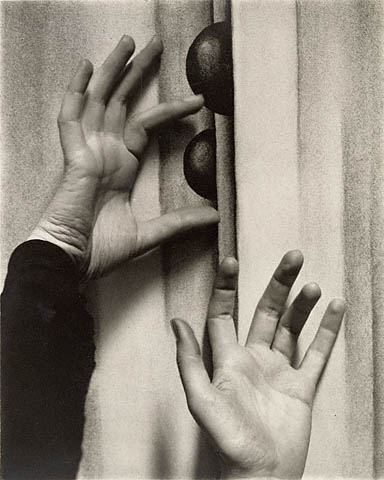 American, New York City, 1919 The camera always stood near the wall-a box maybe a foot square and four or five inches thick. It stood on its rickety tripod with the black head cloth over it-a bit worn with much use-maybe a bulb hanging down on a small rubber cord. Beside the camera was folded a dirty white umbrella that was a large white circle when opened. ... These things were always around nearby so he could grab them... -Georgia O'Keeffe Georgia O'Keeffe and Alfred Stieglitz shared a New York City apartment where he likely made this photograph of her. Many of his early portraits of O'Keeffe-like this one made two years after they became a couple-reflect their passion for each other. Stieglitz launched O'Keeffe's career by exhibiting her paintings and drawings at his New York gallery, 291. Eventually they married, and he continued making portraits of her throughout their lives together. This image displays a degree of eroticism as O'Keeffe's hands-with palms facing the camera-look as if they are about to squeeze a round shape in her Drawing No. 17 . This "portrait" of O'Keeffe was considered highly unconventional at the time. It is like others in the series, most of which are close-ups of her body, often with one of her abstract works of art serving as a background. The figure and background seem to blend seamlessly, forming an image that borders on abstraction.  This photograph, one of more than three hundred images Stieglitz made of O'Keeffe (1887-1986) between 1917 and 1937, is part of an extraordinary composite portrait. Stieglitz believed that portraiture concerned more than merely the face and that it should be a record of a person's entire experience, a mosaic of expressive movements, emotions, and gestures that would function collectively to evoke a life. "To demand the portrait that will be a complete portrait of any person," he claimed, "is as futile as to demand that a motion picture be condensed into a single still."  Georgia O'Keeffe The photographer Alfred Stieglitz sought to bring to America examples of the revolutionary developments of modern art in Europe and to provide support as well for progressive artists and photographers who lived and worked in the United States. His New York gallery "291" exhibited work by such artists as Picasso, Matisse, Marin, Hartley, and O'Keeffe, who would become Stieglitz's wife. He photographed her hundreds of times over the years, varying the poses and focusing on parts of her body in a totally modern approach to the portrait. In Georgia O'Keeffe,the subject seems as confident, monumental, and enigmatically beautiful as her works, one of which appears behind her.  Georgia O'Keeffe, 1920  Portrait of Georgia O'Keeffe, 1920  Georgia O'Keeffe After Return from New Mexico, 1929  Portrait - Georgia O'Keeffe 1929  Alfred Stieglitz, Georgia O'Keeffe, 1933  Georgia O'Keeffe's Hand and Wheel Alfred Stieglitz (American, 1864 - 1946) Between 1917 and 1937, Stieglitz made hundreds of portraits of his wife, painter Georgia O'Keeffe. Endeavoring to capture her unique personality and physical presence, Stieglitz found that the essence of O'Keeffe was expressed not only in her face but also in close-up studies of parts of her body---especially her hands. In 1933, O'Keeffe was completing a long recovery from a nervous breakdown she suffered late in 1932. She was overjoyed to be reunited with her Ford V-8 convertible---a potent symbol of her personal freedom. To convey O'Keeffe's affection for the vehicle, Stieglitz used the motif of her hand caressing the gleaming cover of the car's spare tire.  Georgia O'Keeffe Alfred Stieglitz (American, 1864 - 1946) One of the most important photographers of the 20th century, Stieglitz made hundreds of pictures of his wife, painter Georgia O'Keeffe (1887-1986), recording her physical and psychological evolution from 1917 to 1937. This image was taken at Lake George, where O'Keeffe was completing a long recovery from an emotional breakdown she suffered the previous year. To convey her affection for her Ford V-8 convertible-a potent symbol of her personal freedom-Stieglitz posed her leaning against the shiny spare tire cover on the back of the auto, highlighting her arms and hands. Despite her joy at being united with the vehicle, the darkly toned portrait captures O'Keeffe's lifeless, distant eyes and somber face, revealing her prevailing despondency. ----------------------- 把这些搜到的照片放到一起,才感觉真是伟大,无论是Stieglitz,还是O'Keeffe,都太出色了。 Stieglitz is so great, after I put all photos together. O'Keeffe is such a vivid image in his lens. At the same time, she herself is so brilliant... 评论人:乱看 评论日期:2004-12-11 22:29 there is not much i can add to this... but, then, that is not necessary at all! many regards, sebastian 评论人:dropin 评论日期:2004-12-12 23:42 I understand why Stieglitz focused on her hands although I can't put it in words properly ... when I was eleven years old I had an accident and something in my left hand broke. For some years it was aching, and still today I have a small bump on the back of my hand. Fortunately I can use it without problems. But I got aware of how important my hands are for expressing myself. I got curious about Georgia o'Keeffe now, and found this website: O'Keeffe She said about her very large flower paintings: "Most people in the city rush around so, they have no time to look at a flower. I want them to see it whether they want to or not." Interesting idea. Denise 评论人:dropin 评论日期:2004-12-16 22:12 I agree hands are important. I also got my left wrist hurt in universtisy. It's packed in plaster. And at that time I am in a project. So the first time, I realized, well, I can't work without a hand... This sounds funny, sure cant. But I never realized that. I always thought, well, a pianist can't live without hands. But for me... I am nothing to do with a pianist... Well, in some degree, I share something with a pianist: we all live on keyboads. :) That's a nice connection. So, I took Stieglitz's focus in this way instinctively: well, O'Keeffe is a painter, that's another kind of people living on hands. Em, actually a lot of people living on hands. It's not the full reason. At the same time, her hands is nice and expressive and so on... :) About her big flowers, there is another insteresting line on a memorizing stamp sets of her red poppy, 1927 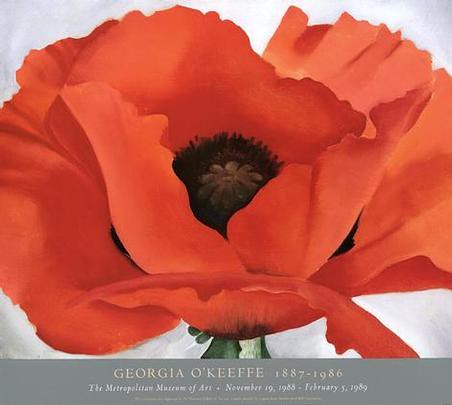 'Nobody sees a flower, really - it's so small - We haven't time, and to see takes time, like to have a friend takes time.' Goregia O'Keeffe 评论人:乱看 评论日期:2004-12-19 12:32 this is sebastian finally i found some words (although i still think the pictures (both stieglitz' photos and o'keefe's paintings) speak for themselves). hands are very expressive. they "talk" in a way people barely can control. people are used to care for their words - they won't say something they want to keep secret - but in most cases hands still talk the truth. and because hands are so well developed to do almost everything, they have also the power to express. so, it is no surprize, that as soon as you take care of hands, when doing portraits, the results (the protraits) gain a lot in quality. and stieglitz did a brilliant job! 评论人:dropin 评论日期:2004-12-19 22:22
站在拥挤的地铁门口,灯光暗影楼梯人群呼啸而来,又转瞬即去,漠漠的疲倦里感到沮丧。该做什么呢?努力做个好技工并不能带来什么慰籍,更何况,真要当个好技工也谈何容易。 做什么呢?戒掉晚上的无聊电视剧是个明智之举,越不看,越觉得那些都愚蠢之极。麻烦的是50多个频道里就没有一个真正意义的音乐频道。热闹的演艺新闻和各色MTV后,居然是没完没了的劣质广告。 看本书吧,拍拍掉灰尘。 叶芝的几行诗句就能让人安静,当然还是觉得译文不好,可惜原文尚不能读顺当。 然后就翻到了O'Keeffe,从头开始读,这次把字加进去看。 书,写得潦草,语句不通的地方挺多,好在我看起来也是一目十行,常常跳字漏字,没什么妨碍。 看图片,云上的世界很稀疏平常,但原来是个巨大的画幅,大得一些展厅都运不进,这样想来效果应该是完全不同。O'Keeffe老年时的作品,因为有邻居帮忙,所以记述里看出作幅画那么麻烦,完全是个体力活。 反复提到Stieglitz的照片,对Stieglitz给她拍的那许多照感到很好奇。多好,一流的摄影家和一流的人物,还有什么更好呢? Stieglitz死后整理展出他的作品,因为照片尺寸各异,展览馆提议要修剪空白边缘便于码齐了好运输,说他们也是这么处理伦勃朗的,O'Keeffe立刻回击,‘那是因为他的妻子不在场。’ 伦勃朗啊,他们这么处理他。这个名字是唯一在卢浮宫给我留下深刻印象的画家,在巨大的卢浮宫里努力竞走时。那幅画很神奇,画里的老者在书桌前忧虑沉思惶惑,身后的女子探头安抚他,柔和而充满慰籍,也许她是充满怜悯的灵感之神。灰暗的画面,我能清晰的感受到,是这个画面之外的一个伟大的心灵在沉思忧伤,它充满智慧,就隐藏在这画面和我之间的空气上方。时间空间在它面前软弱无力。 那幅画下面用金色的花体字标着,Rembrandt。长久当文盲让我觉得自己连读阿拉伯数字都不一定能理解正确,这个花体字让我很疑惑,猜想名字是不是会随语言不同而改变。猜想这个大概就是伦勃朗吧,反正也从没看过这个名字本来应该怎么写。 嗯,他们居然这么处理他。Stieglitz很走运,有O'Keeffe坚持,一点多余的空白边也不能裁。 Stieglitz, Alfred American (1864-1946)  "Stieglitz photographed me first at his gallery "291" in the spring of 1917. My hands had always been admired since I was a little girl. But I never thought much about it. He wanted head and hands and arms on a pillow in many different positions. I was asked to move my hands in many different ways also my head and I had to turn this way and that. Stieglitz had a very sharp eye for what he wanted to say with the camera. When I look over the photographs Stieglitz took of me, some of them more than sixty years ago, wonder who that person is. It is as if in my one life I have lived many lives. His idea of a portrait was not just one picture. His dream was to start with a child at birth and photograph that child in all of its activities as it grew to be a person and on throughout its adult life. As a portrait it would be a photographic diary." Georgia O'Keeffe, 1978 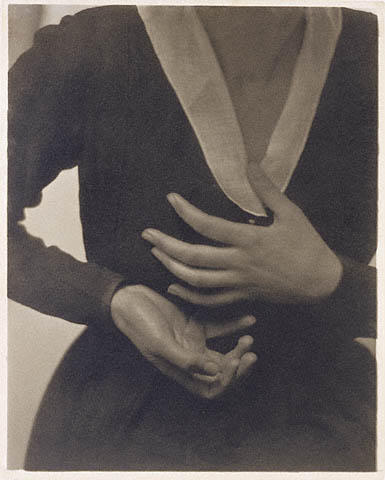 American, June 4, 1917 [Georgia O'Keeffe] is much more extraordinary than even I had believed. In fact I don't believe there has ever been anything like her. Mind and feeling very clear, spontaneous--& uncannily beautiful, absolutely living every pulse beat. Early in Alfred Stieglitz's relationship with O'Keeffe he wrote this adulatory description of her to a friend. Stieglitz made this expressive study of O'Keeffee's nearly dancing hands and her torso, dressed in a crisp black dress with a sheer, voile shawl collar, reminiscent of the one she wore when they first met at his gallery. O'Keeffe, by then already an accomplished painter, expressed herself eloquently through her hands, and Stieglitz recognized their emotive potential. 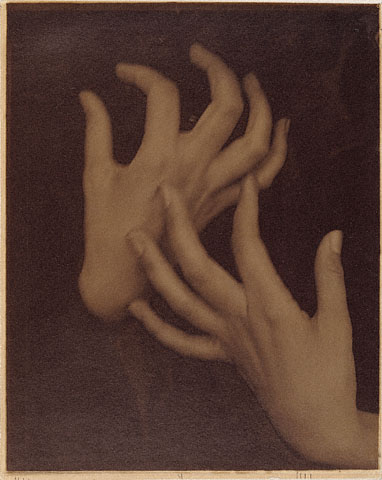 American, 1918 "My hands had always been admired -but I never though much about it," recalled Georgia O'Keeffe when she looked at this photograph some sixty years after it was made. As part of the consuming passion for O'Keeffe that drove Alfred Stieglitz to leave his first wife and child, he conducted a great love affair with her hands through his camera. From the very beginning of their relationship, Stieglitz photographed O'Keeffe, eventually produced a cumulative portrait of more than 325 photographs. Here photographed so that only her hands are visible, the dynamism of her gesture evokes the rhythms of music and dance as well as the abstract, biomorphic shapes of O'Keeffe's own drawings and paintings. 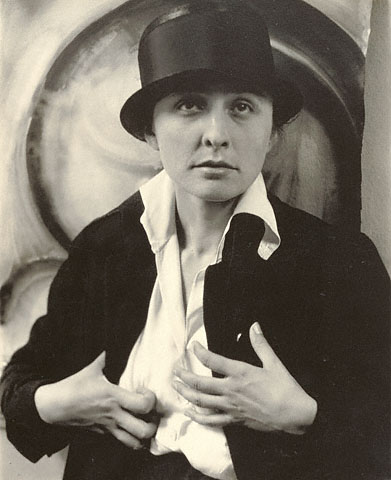 American, 1918 A striking figure in a smart hat, seductively open white shirt, and black jacket, Georgia O'Keeffe stands in front of one of her paintings and clutches at her breasts as if her hands contain a life force unto themselves. Her penetrating gaze above the camera transports her to a space the viewer cannot share. From 1917 through the mid-1930s, Alfred Stieglitz photographed O'Keeffe, with whom he began a passionate relationship in 1918. He called the extended series of photographs he made of her Georgia O'Keeffe: A Portrait.  A Portrait: Georgia O'Keefe, 1918 One of the most significant photographers of the early twentieth century, Stieglitz said: "I was born in Hoboken. I am an American. Photography is my passion. The search for Truth my obsession." He also introduced modern European art to America through exhibitions in his New York galleries and supported the work of American modernist painters, including Georgia O'Keeffe, who became his wife. This image is part of Stieglitz's cumulative portrait in time, several hundred photographs made of O'Keeffe between 1917 and 1933. He believed that a single image was not always sufficient to capture the complexity of a human personality and that, as long as it expressed some aspect of the sitter, any part of the body could be a portrait.  O'Keeffe Hands and Thimble 1919
|























































